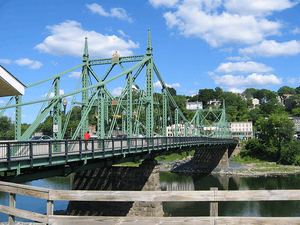Northampton Street Bridge
| Northampton Street Bridge | |
|---|---|
 | |
| Carries | 3 lanes of Northampton Street and 2 sidewalks |
| Crosses | Delaware River |
| Locale | Easton, PA, and Phillipsburg, NJ |
| Official name | Northampton Street Toll Supported Bridge |
| Other name(s) |
The Free Bridge Easton-Phillipsburg Bridge |
| Maintained by | Delaware River Joint Toll Bridge Commission |
| Preceded by | Easton-Phillipsburg Toll Bridge |
| Followed by | Lehigh Valley Railroad Bridge |
| Characteristics | |
| Total length | 560 feet (170 m) |
| Load limit | 3 short tons (2.7 t) |
| History | |
| Designer | James Madison Porter III |
| Opened | 1896 |
| Replaces |
Ferry (1739-1806) Covered bridge (1806-1896) |
The Northampton Street Bridge is a bridge that crosses the Delaware River, connecting Easton, Pennsylvania and Phillipsburg, New Jersey, United States. It is maintained by the Delaware River Joint Toll Bridge Commission despite not being a toll bridge. It is known locally as the "Free Bridge" thus distinguishing it from the Easton-Phillipsburg Toll Bridge just upstream to the north. The crossing was first a ferry crossing run by David Martin, beginning in 1739. The original wooden bridge opened on October 14, 1806. The original bridge was designed and built by Timothy Palmer, one of the most famous bridge builders of his time. Palmer's covered bridge at Easton endured many floods and storms while other bridges fell.
However, by the late nineteenth century, when horse-drawn streetcars were replaced by trolley cars, the old wooden bridge could no longer handle the demands of traffic and a new structure was erected in 1895. The new bridge was designed by James Madison Porter III, an alumnus of nearby Lafayette College and later a professor of civil engineering there. Porter hailed from a family long prominent in Easton and Pennsylvania history.
Tolls were charged until 1921, when the DRJTBC bought it from the Delaware Bridge Company.[1]
The Northampton Street Bridge sustained major damage during Hurricane Diane when floodwaters, 44 feet (13 m) above normal water level, topped the roadway of the bridge on August 19, 1955. Although the bridge withstood this topping, when large floating wooden pieces of the Portland-Columbia covered bridge which was washed out in the same flood waters were jammed against the bridge, the center of the span was torn away.
Tolls on the Easton-Phillipsburg Toll Bridge were ten cents at the time, but they were lowered to five cents until the Northampton Street Bridge was repaired. The United States Army Corps of Engineers installed two parallel Bailey bridges between the damaged free bridge and the toll bridge. Each Bailey bridge had four spans. These remained in place until the free bridge was repaired.
Repairs carried out by Bethlehem Steel over the next two years made the bridge usable but the flood damage left a readily apparent sag in the center span that remains today.[2]
Another series of improvements were completed in the summer of 2002 and included structural steel repair and replacement, painting, and the replacement and installation of sidewalk decking and new pedestrian railings.
The bridge is currently posted for a three-ton weight limit and a fifteen-mile per hour speed limit.
See also
- List of bridges documented by the Historic American Engineering Record in New Jersey
- List of bridges documented by the Historic American Engineering Record in Pennsylvania
- List of crossings of the Delaware River
References
- ↑ Lance Metz, Northampton Street Bridge Took Hit In '55 Hurricane, The Morning Call, October 17, 1993
- ↑ Spivey, Justin M. (August 1998). "Northampton Street Bridge" (PDF). Historic American Engineering Record. Washington, D.C.: Library of Congress. p. 1. Retrieved January 31, 2014.
External links
| Wikimedia Commons has media related to Northampton Street Bridge. |
- DRJTBC Official page
- Historic American Engineering Record (HAER) No. PA-502, "Northampton Street Bridge, Spanning Delaware River at Northampton Street, Easton, Northampton County, PA", 16 photos, 4 data pages, 2 photo caption pages
- Northampton Street Bridge at Structurae
Coordinates: 40°41′30″N 75°12′14″W / 40.691545°N 75.204004°W